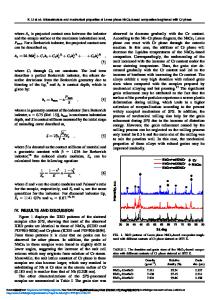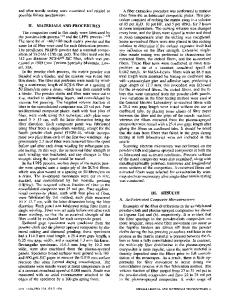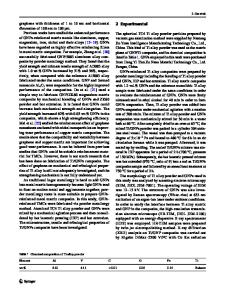Microstructure and mechanical properties of 3D C f /SiBCN composites fabricated by polymer infiltration and pyrolysis
- PDF / 4,770,998 Bytes
- 11 Pages / 595.22 x 842 pts (A4) Page_size
- 47 Downloads / 470 Views
ISSN 2226-4108 CN 10-1154/TQ
Research Article
Microstructure and mechanical properties of 3D Cf/SiBCN composites fabricated by polymer infiltration and pyrolysis Bowen CHENa,b,c,†, Qi DINGa,b,†, Dewei NIa,b,*, Hongda WANGa,b, Yusheng DINGa,b,*, Xiangyu ZHANGa,b, Shaoming DONGa,b,d a
State Key Laboratory of High Performance Ceramics and Superfine Microstructure, Shanghai Institute of Ceramics, Chinese Academy of Sciences, Shanghai 200050, China b Structural Ceramics and Composites Engineering Research Center, Shanghai Institute of Ceramics, Chinese Academy of Sciences, Shanghai 200050, China c University of Chinese Academy of Sciences, Beijing 100049, China d Center of Materials Science and Optoelectronics Engineering, University of Chinese Academy of Sciences, Beijing 100049, China Received: May 29, 2020; Revised: August 5, 2020; Accepted: August 25, 2020 © The Author(s) 2020.
Abstract: In this work, three-dimensional (3D) Cf/SiBCN composites were fabricated by polymer infiltration and pyrolysis (PIP) with poly(methylvinyl)borosilazane as SiBCN precursor. The 3D microstructure evolution process of the composites was investigated by an advanced X-ray computed tomography (XCT). The effect of dicumyl peroxide (DCP) initiator addition on the crosslinking process, microstructure evolution, and mechanical properties of the composites were uncovered. With the addition of a DCP initiator, the liquid precursor can cross-linking to solid-state at 120 ℃. Moreover, DCP addition decreases the release of small molecule gas during pyrolysis, leading to an improved ceramic yield 4.67 times higher than that without DCP addition. After 7 PIP cycles, density and open porosity of the final Cf/SiBCN composite with DCP addition are 1.73 g·cm–3 and ~10%, respectively, which are 143.0% higher and 30.3% lower compared with the composites without DCP addition. As a result, the flexural strength and elastic modulus of Cf/SiBCN composites with DCP addition (371 MPa and 31 GPa) are 1.74 and 1.60 times higher than that without DCP addition (213 MPa and 19.4 GPa), respectively. Keywords: Cf/SiBCN; ceramic matrix composites; dicumyl peroxide (DCP); X-ray computed tomography (XCT)
1
Introduction
Siliconboron carbonitride (SiBCN) ceramics have † Bowen Chen and Qi Ding contributed equally to this work. * Corresponding authors. E-mail: D. Ni, [email protected]; Y. Ding, [email protected]
attracted considerable interests as their excellent thermal stability, high-temperature mechanical properties, and high creep resistance at elevated temperatures [1–4]. Based on these excellent properties, SiBCN ceramics are considered as a key candidate for applications under extreme conditions in the aerospace industry, such as the heat shield and leading edges of advanced aircraft [5–7]. However, low toughness and poor
www.springer.com/journal/40145
2
J Adv Ceram 2020, 9(6): 0–0
thermal shock resistance restrict the wide application of SiBCN ceramics [8,9]. The Cf/SiBCN composites with carbon fiber as reinforcement fundamentally overcome the b
Data Loading...











